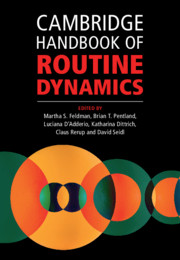Book contents
- Cambridge Handbook of Routine Dynamics
- Cambridge Handbook of Routine Dynamics
- Copyright page
- Contents
- Figures
- Tables
- Contributors
- Preface
- Chapter 1 What Is Routine Dynamics?
- Part I Theoretical Resources for Routine Dynamics Research
- Part II Methodological Issues in Routine Dynamics Research
- Part III Themes in Routine Dynamics Research
- Chapter 15 Truces and Routine Dynamics
- Chapter 16 Context, Embeddedness and Routine Dynamics
- Chapter 17 Routine Interdependence
- Chapter 18 Cognition and Routine Dynamics
- Chapter 19 Time, Temporality and History in Routine Dynamics
- Chapter 20 Replication and Routine Dynamics
- Chapter 21 Innovation Work and Routine Dynamics
- Chapter 22 Design and Routine Dynamics
- Chapter 23 Algorithms and Routine Dynamics
- Chapter 24 Complexity in Routine Dynamics
- Chapter 25 Bodies and Routine Dynamics
- Chapter 26 Emotions and Routine Dynamics
- Chapter 27 Professional Identity and Routine Dynamics
- Chapter 28 Occupations, Professions and Routine Dynamics
- Chapter 29 Routine Dynamics and Management Practice
- Chapter 30 Project-Based Temporary Organizing and Routine Dynamics
- Chapter 31 Self-Managed Forms of Organizing and Routine Dynamics
- Chapter 32 Unexpected Events and Routine Dynamics
- Part IV Related Communities of Thought
- Author Index
- Subject Index
- References
Chapter 25 - Bodies and Routine Dynamics
from Part III - Themes in Routine Dynamics Research
Published online by Cambridge University Press: 11 December 2021
- Cambridge Handbook of Routine Dynamics
- Cambridge Handbook of Routine Dynamics
- Copyright page
- Contents
- Figures
- Tables
- Contributors
- Preface
- Chapter 1 What Is Routine Dynamics?
- Part I Theoretical Resources for Routine Dynamics Research
- Part II Methodological Issues in Routine Dynamics Research
- Part III Themes in Routine Dynamics Research
- Chapter 15 Truces and Routine Dynamics
- Chapter 16 Context, Embeddedness and Routine Dynamics
- Chapter 17 Routine Interdependence
- Chapter 18 Cognition and Routine Dynamics
- Chapter 19 Time, Temporality and History in Routine Dynamics
- Chapter 20 Replication and Routine Dynamics
- Chapter 21 Innovation Work and Routine Dynamics
- Chapter 22 Design and Routine Dynamics
- Chapter 23 Algorithms and Routine Dynamics
- Chapter 24 Complexity in Routine Dynamics
- Chapter 25 Bodies and Routine Dynamics
- Chapter 26 Emotions and Routine Dynamics
- Chapter 27 Professional Identity and Routine Dynamics
- Chapter 28 Occupations, Professions and Routine Dynamics
- Chapter 29 Routine Dynamics and Management Practice
- Chapter 30 Project-Based Temporary Organizing and Routine Dynamics
- Chapter 31 Self-Managed Forms of Organizing and Routine Dynamics
- Chapter 32 Unexpected Events and Routine Dynamics
- Part IV Related Communities of Thought
- Author Index
- Subject Index
- References
Summary
In this chapter, we shed light on bodies in the dynamics of routines. Though the body has just begun to be theorized in Routine Dynamics research, the body is, nonetheless, pervasive. We show how ubiquitous the bodies are in Routine Dynamics research by documenting the embodied orientation to and from performing, to and from patterns, and to and from situation or materiality in 13 reference articles. By exploring one of these articles in more depth, we show how theorizing the body more explicitly has potential for deepening our understanding of the processual mechanisms of routine dynamics.
Keywords
- Type
- Chapter
- Information
- Cambridge Handbook of Routine Dynamics , pp. 343 - 356Publisher: Cambridge University PressPrint publication year: 2021
References
- 5
- Cited by

